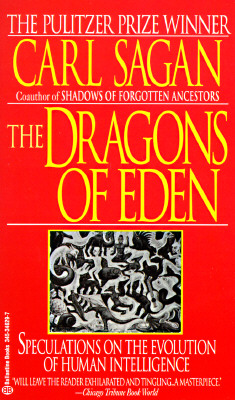

| THE DRAGONS OF EDEN: Speculations on the Evolution of Human Intelligence Carl Sagan New York: Random House, 1977 |
Rating: 5.0 High |
|||
| ISBN-13 978-0-394-41045-6 | ||||
| ISBN 0-394-41045-9 | 263pp. | HC/BWI 1 | $8.95 | |
As the title indicates, this is a work of speculation. It grew out of a lecture2 the author gave. Thus, it has some of the nature of an after-dinner speech — it rambles somewhat, and emphasizes wit more than rigor. On page 5, Sagan disclaims any special expertise in the fields of neuroanatomy and brain physiology. Also, he warns us that he will be weaving myth into the narrative along with the science.
The book presents the "Cosmic Calendar" well-known from the PBS production Cosmos. It describes the molecular basis of heredity and proposes some quantitative assessments of the overall mutation rate and the relation between brain size and certain behavioral skills. Then it turns to fetal development and the structure of the brain and nervous system (the so-called "Triune Brain" of Maclean.) The central idea here is that there are three segments of the brain, which operate somewhat independently and at cross-purposes. Sagan relates this, and the left-right hemispheric segregation of brain function, to the tenets of Freudian psychotherapy. Finally, he speculates that in the future, as computers continue to improve, much of our knowledge and even our intelligence will depend on intimate collaboration with these devices.
A number of writers have commented on errors in this book. One example cited is the claim (page 43) that the brain processes information at a peak rate of 5,000 bits per second. It seems clear to me (as it did to the writer who pointed this out) that the visual apperception of complex scenes takes place much faster. However, Sagan was estimating the rate of visual memory recall specifically, and in any case the rate must vary widely depending on what task is being performed.
Another writer says that Sagan refers to fishes as invertebrates. (I have not located this alleged error.) On page 21, Sagan says, "With a few unimportant exceptions, the hereditary nucleic acid is always the molecule called DNA." He never names these exceptions, and on page 23 he strongly implies that all life on Earth depends on DNA.
I also question some of his conclusions. For example, on page 94 he says, "The connection between murder and invention has been with us ever since [Cain slew Abel]. Both derive from agriculture and civilization." I believe it is well-established that hunter-gatherer societies knew murder. (A harder question is how well-known this was in 1977.) They certainly knew invention, in arrowheads and other weapons, although they may not have conceptualized it the way we do. And on page 173, I find the speculations quoted below:
Lesions in the monkey brain of the neocortical areas responsible for speech in humans fail to impair their instinctual vocalizations. The development of human language must therefore involve an essentially new brain system and not merely a reworking of the machinery for limbic cries and calls. Some experts in human evolution have suggested that the acquisition of language occurred very late—perhaps only in the last few tens of thousands of years—and was connected with the challenges of the last ice age. But the data do not seem to be consistent with this view; moreover, the speech centers of the human brain are so complex that it is very difficult to imagine their evolution in the thousand or so generations since the peak of the most recent glaciation. |
The evidence suggests that in our ancestors of some tens of millions of years ago there was a neocortex, but one in which the left and right hemispheres served comparable and redundant functions. Since then, upright posture, the use of tools, and the development of language have mutually advanced one another, a small increment in language ability, for example, permitting the incremental improvement of hand axes, and vice versa. The corresponding brain evolution seems to have proceeded by specializing one of the two hemispheres for analytical thinking. |
It may be so that complex brain structures cannot evolve in 33,000 years (the usual definition of a generation is 33 years). But to me this seems possible, especially given a drastic lowering of population size, with fragmentation into isolated groups and the extreme selection pressure applied by the cold climate. Another factor is that not knowing what the brain looked like at the start of that span makes it hard to assess how much change took place. But this is my speculation, and Sagan's would be at least as good.
I have to wonder, too, about the divergence of hemisphere functions. What could possibly drive it?
This review needs rework...3
But none of these errors, real or alleged, amounts to more than a quibble. A more serious objection is that Sagan in places allows his scientific conclusions to be influenced by a liberal (in the political sense) bias. I would agree with this last. I nevertheless feel that given the disclaimers mentioned above, such lapses do not diminish this book in any significant way. Its many references to current scientific investigations by themselves would justify its publication. Add to this the extensive knowledge of myth and prehistory demonstrated here, and you have a very worthwhile addition to any library.

 To contact Chris Winter, send email to this address.
To contact Chris Winter, send email to this address.